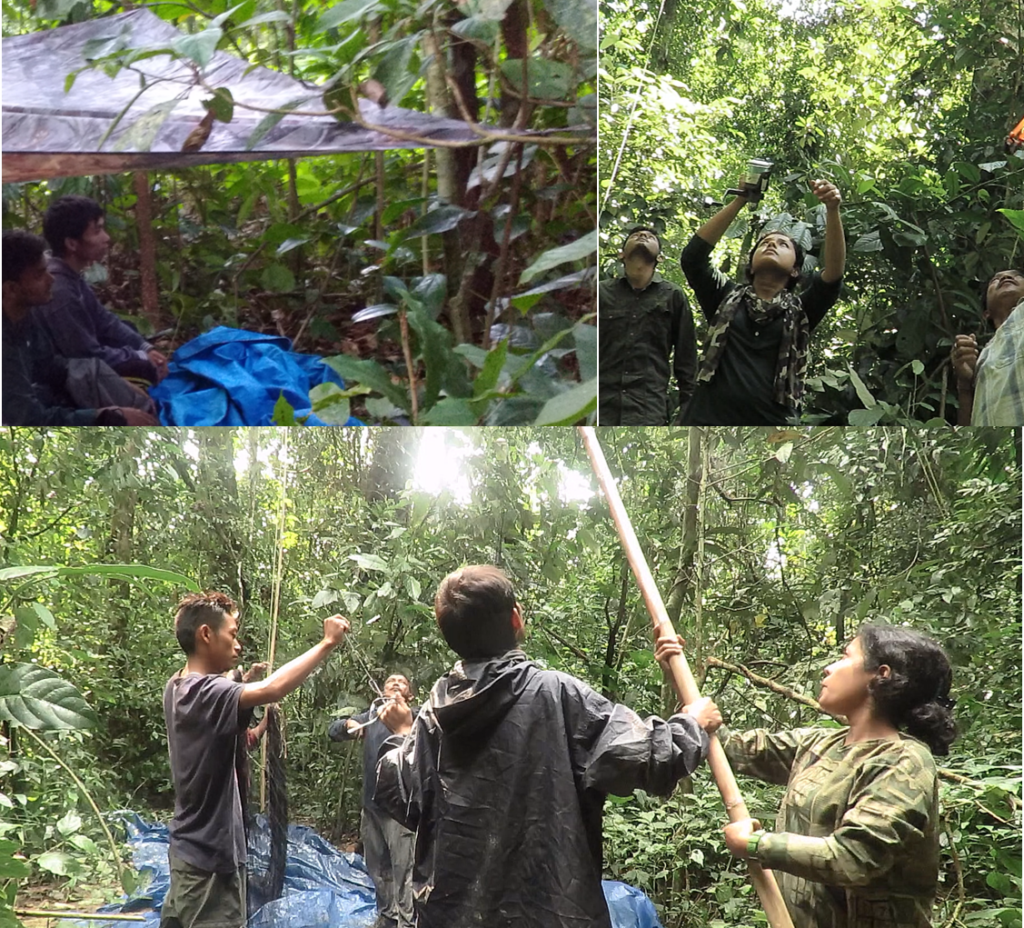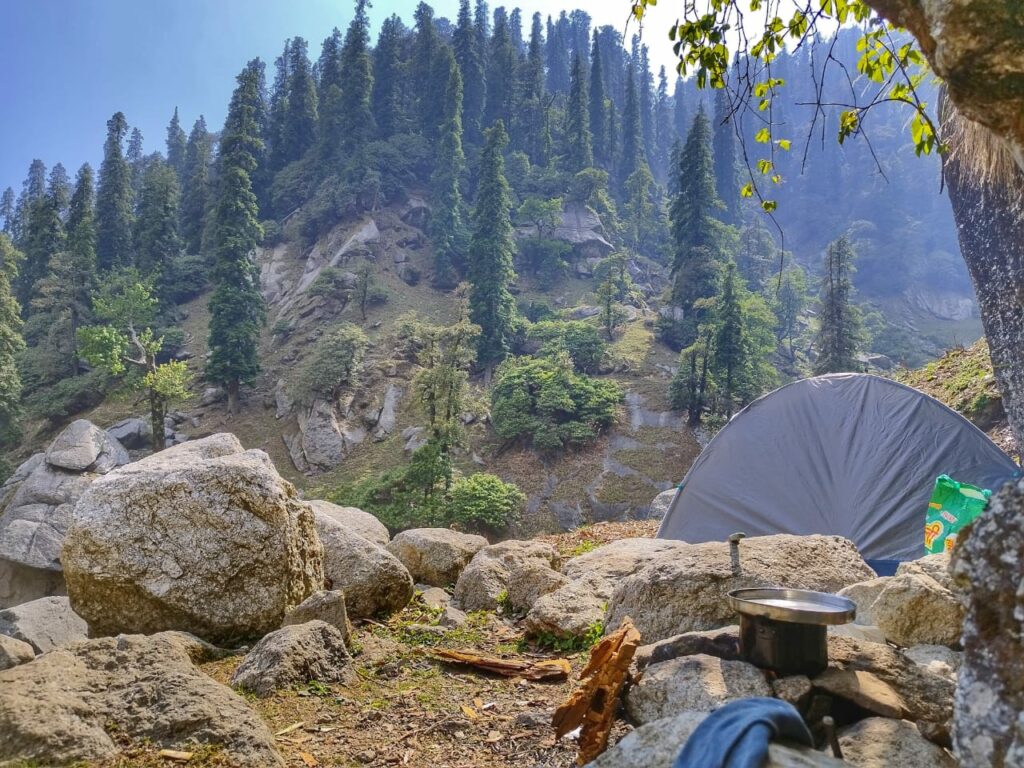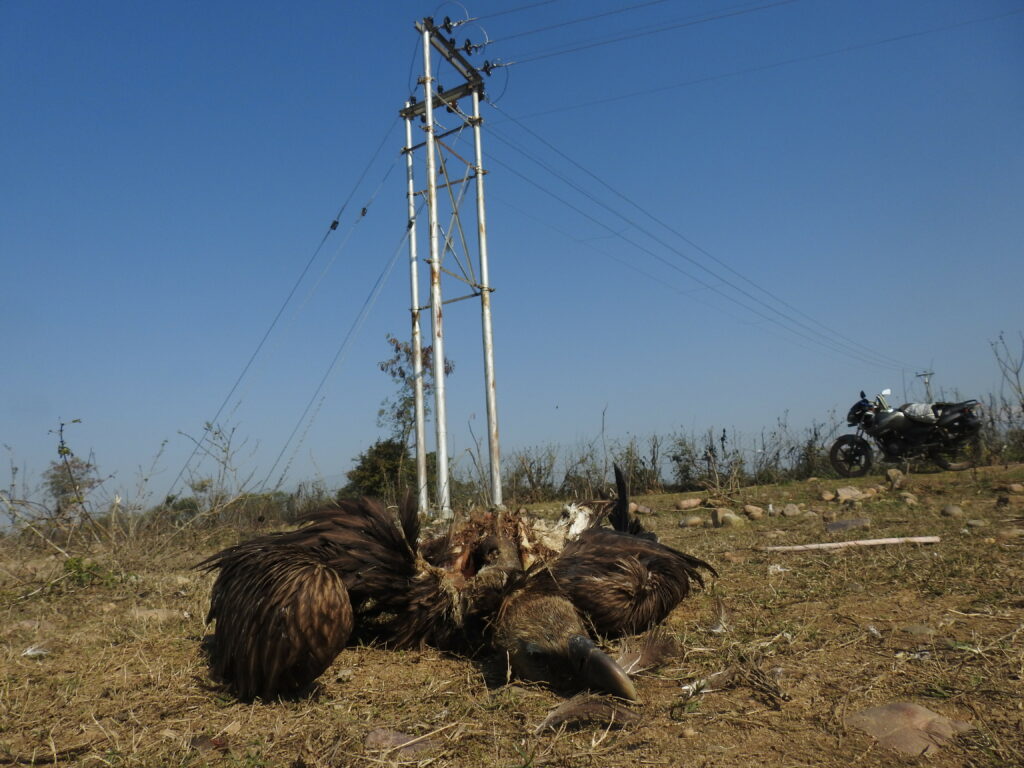It was in the midst of post-monsoon in Pakke Tiger Reserve, a tropical semi-evergreen forest of Arunachal Pradesh where I was volunteering with the hornbill project at NCF. Fruits form a main part of the diet of hornbills and they can disperse more than 90% of the seeds of fruits they consume, far away from the fruiting trees. This helps regenerate forests and restore connection between forest patches. At Pakke, we were trying to understand how far they disperse seeds from the fruiting trees and if it varies across sex and species.
For studying this, our first job was to trap and tag Great Hornbills and Wreathed Hornbills to understand their movement strategies. Our days on the field used to begin very early. We would get up at 1:45 am and start from the base camp at 2:00 am every day. We used to enter Pakke before sunrise and put up traps (canopy-mounted mist nets) for the hornbills.
As the sun rose, sun rays lit up the forest gradually: first the leaves, the fruits, and then the entire tree. The sounds we heard changed with every passing hour. Around 6:00 am, the langurs started having their breakfast around us, whilst jumping from one tree to another. At about 7:30, we heard calls of Barking Deer while we waited in the forest in a small hide covered by a tirpal, a waterproof tarpaulin sheet.
Hornbills are sensitive birds, and even a minor disturbance affects their chances of getting trapped. Almost everyday, we would wait for a long time and yet no bird would get trapped. It had been many months in the forest but we had not been able to trap and tag a single Great Hornbill.
 Canopy mounted mist net used in Pakke to trap hornbills (top left), waiting at the tent for Hornbill trap (top right) and setting up a canopy net (bottom). Photos: Sheetal
Canopy mounted mist net used in Pakke to trap hornbills (top left), waiting at the tent for Hornbill trap (top right) and setting up a canopy net (bottom). Photos: Sheetal
It was one such morning in the forest of Pakke. We had almost lost all hopes of getting a hornbill trapped. That day, we had put up our trap between two fig trees. While we were waiting in the hide, we suddenly heard the loud flapping sound of a Great Hornbill approaching. It was heading towards the fruiting tree on which we had mounted the net, and yes – it was trapped! We had caught our first male Great Hornbill and it was my first experience seeing a Great Hornbill so up close. We took its measurements and tagged it. This process took just a few minutes and we released it from where we had caught it, right under the fruiting tree. It was a once-in-a-lifetime experience to learn how to handle one of my most favorite species. The results of this study have been published here.
 A tagged male Great Hornbill from Pakke Tiger Reserve
A tagged male Great Hornbill from Pakke Tiger Reserve
This is how my love for birds and research took shape..
I cannot recollect there being a particular day or an incident that caught my interest in birds and nature. It was a gradual process which got me here. I was always passionate about watching all kinds of animals, from Purple Sunbirds and Asian Palm Civets to Rat snakes and frogs, which were usually seen every day in my backyard. I studied at Patha Bhavan in Kolkata and my school played a role in making me what I am today. There was an established nature club in my school. We used to go to nature workshops in fields to learn new things about nature. My birding experiences started from watching sunbirds and barbets forage amongst the drumstick flowers, and the male Asian Koels constantly battling while sitting on a false Ashoka tree. I used to watch colonies of Openbill Storks and cormorants in Rabindra Sarobar near my house.
My grandfather was an occasional hunter. He owned a pair of binoculars (Zenith 8*50) and an air gun. In his days, the most common species to hunt were the Balihans (Cotton Pygmy-Goose) and the Saral (Lesser Whistling-Duck). I carried the same binoculars on my first field trip from college to Nagzira Tiger Reserve. Not just my grandfather, but my father too influenced me in getting into the world of wildlife. In my childhood, I visited several national parks such as Kaziranga, Sunderban, Periyar, Eravikulam and Kuldiha Wildlife Sanctuary with my family. These trips have played a prominent role in revamping my interest in birds.
 Kaziranga field trip with parents
Kaziranga field trip with parents
Getting into research, however, was not planned. I was initially interested in being a veterinary doctor but eventually, while pursuing my bachelors and masters in Zoology from Calcutta University, I was drawn towards Ornithology. During my Masters, I joined the Nature Conservation Foundation where I worked on a project studying the seed dispersal of hornbills in Pakke Tiger Reserve in Arunachal Pradesh.

Team NCF during field work at Pakke Tiger Reserve: (top)Team Hornbill telemetry NCF, from left to right: Kumar Daju,Thonger, Pranjal Mahananda, Rohit Naniwadekar, Khem Daju, Talli, Turuk and me. Photo:Sheetal. (Bottom) Left to right: Me, M Ananda Kumar, Aparajita Dutta and Pranjal Mahananda. Photo: Kumar Daju.
This project inspired me to work towards conservation of birds. After NCF, I worked at the Kolkata Zoo for a few months on a project studying why migratory birds that used to stop at the zoo lake earlier were not using it as a stopover point anymore. In 2016, I joined the Salim Ali Centre for Ornithology and Natural History (SACON) with Dr.H.N Kumara to understand the impact of windmills on birds in Karnataka. In 2017, I joined the Wildlife Institute of India as a project fellow to study the conservation of the Black-necked Cranes in Arunachal Pradesh with Dr. Gopi GV. Working at WII also gave me an opportunity to participate in a workshop on the recording of bird calls conducted by eBird and Macaulay Library. My bird call recording skills gained a new direction after attending these workshops.
 Me Observing of Vultures at Kangra,Himachal Pradesh. Photo: Ramesh
Me Observing of Vultures at Kangra,Himachal Pradesh. Photo: Ramesh
 Bird recording workshop with Macaulay library and team. Photo: Debanjan
Bird recording workshop with Macaulay library and team. Photo: Debanjan
In 2019, I joined as a PhD student, also in WII, to study the critically endangered White-rumped Vultures in Himachal Pradesh under the guidance of Dr. Gautam Talukdar. Currently, I am in the final year of my PhD. My study aims to tag vultures from Kangra, Himachal Pradesh and study the breeding status and movements of wild White-rumped vulture populations.
 Tagging and monitoring vultures
Tagging and monitoring vultures
 A pair of White-rumped Vultures at their nest in Kangra
A pair of White-rumped Vultures at their nest in Kangra
 International Vulture Awareness day at Pong, Kangra, HP. Photo: Manoj
International Vulture Awareness day at Pong, Kangra, HP. Photo: Manoj
I love what I do because…
As I enter the forests every day, there is something to learn from nature. My experiences have taught me to survive with minimal needs and protect myself from reptiles and large carnivores. These survival strategies are of utmost importance in my day-to-day life today.
One of the most important aspects of my work is to spread awareness among locals about the White-rumped Vulture and its importance in the ecosystem. After all these years of working in the field, I have realized that the majority of locals are not even aware of a vital species like the White-rumped Vulture being present in their backyard. At my field site, they do not understand why someone has to come from outside to save their vultures. “Are they all that important?”, is the question I get asked regularly. They are not aware of wildlife laws and why these laws are essential. Through my work, I wish to make people aware that working for nature is extremely crucial for protecting ourselves too.
 Daily lunch preparation during fieldwork Photo: Manoj
Daily lunch preparation during fieldwork Photo: Manoj
Challenges I faced..
Being a researcher in the field of wildlife, I have faced several challenges – I have received threats asking me to stop my work to statements such as “Do your work and leave, you cannot change anything in one year!”.
I can describe one such incident which took place when I was working on the Black-necked Crane in the valley of Nyamjang Chu river in Arunachal Pradesh. This is one of the few wintering sites of Black-necked Cranes in India. However, the valley is highly disturbed by sand mining carried out by contractors and dynamite blasting of mountains for road construction. That year, the species didn’t even land in the valley due to all these disturbances to its habitat. When I, with my local assistant Pemba Tsering Romo went to speak with a political leader regarding the importance of the Black-necked Crane and tried to explain why the construction work should stop, we got a direct ‘no’ as a response.
The local people do honor the Black-necked Crane as an important species, but the leader was of the thought that there were many other places for the birds to use and that there was no need to stop sand mining in that stretch. In this field, making a non-wildlife person understand its importance is extremely difficult, especially as an outsider. Working with top politicians particularly, can sometimes be very tricky. Only after the locals united and stood up for the issue, did the matter get resolved.
 (Left) A Black-necked Crane, Photo: Pemba; (Right) interactions with locals about the Black-necked Crane habitat degradation at Zemithang.
(Left) A Black-necked Crane, Photo: Pemba; (Right) interactions with locals about the Black-necked Crane habitat degradation at Zemithang.
Similarly, in my current study, we are observing quite a lot of electrocution of vultures, but when I, with my field assistant Manoj Kumar visited the State Electricity Board and requested them to insulate electricity poles, we failed to find a solution to the problem. All of these issues take a long time and consistent effort to get resolved.
 Electrocution is a major threat to the population of vultures at Kangra
Electrocution is a major threat to the population of vultures at Kangra
My advice for young researchers is…
Talking about advice for young researchers, firstly, I would say, never undo your first instinct. Do you really want to do research on birds or do you just want to observe birds and nature? Do you want to connect your bird observation with science? If you do, research is for you. If not, there are multiple other ways of working with nature, like journalism, being a naturalist or a birding guide, a writer etc.
Second, if you want to be a researcher in ornithology, it is important to study every detail of the species, and not only the topic you are working on. For example, look at the natural history and beyond it. Scientific research can answer many questions, but some mysteries remain unsolved or change based on where or when they are studied.Therefore, it is essential to consider the species’ ecology, including the specific location, season of study, and the habitat’s connection to the species. Also,spend time in the field to observe birds in their natural habitats. Learning to identify species by sight and sound is crucial. Thirdly, involve the locals and promote birdwatching in the community. The joy one gets by interacting with locals is far beyond the joy from anything else. Participating in or leading citizen science initiatives can provide valuable data and help you engage with the public.
 Birdwatching with locals
Birdwatching with locals
Finally, the most important thing is to always plan ahead. It not only includes planning for data collection but also planning for funds before starting any project. Also, there are several online courses which you can do to improve your understanding in conservation research. One of them I have done was an Elearning Course on Wildlife Conservation Research with Oxford University, Wildlife Conservation and Research Unit (WildCru) . The course helped me a lot in understanding ornithology as a scientific field. Keep looking for opportunities which can help you grow in your own field and of course, keep birding!
Malyasri Bhattacharya
[email protected]
Phd Research Scholar, Wildlife Institute of India
Twitter / X account
Instagram Account


Nice work dude 👍🏽 Keep inspiring the future generation of conservationists!!
Hello Malyasri! Absolutely fascinated by your story. I can well appreciate the toil, hard work and sacrifices you have made. Hats off to you 🫡